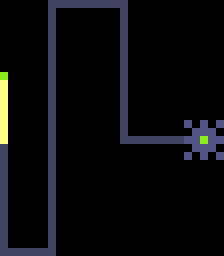Difference between revisions of "Element:WIFI"
(Improved the "Usage" section. Much more work needs to be done.) |
|||
| (14 intermediate revisions by 7 users not shown) | |||
| Line 6: | Line 6: | ||
| identifier = DEFAULT_PT_WIFI | | identifier = DEFAULT_PT_WIFI | ||
| name = WIFI | | name = WIFI | ||
| − | | description = Wireless transmitter, transfers spark to any other | + | | description = Wireless transmitter, transfers spark to any other WIFI on the same temperature channel. |
| colour = 40A060 | | colour = 40A060 | ||
| menusection = SC_ELEC | | menusection = SC_ELEC | ||
| Line 37: | Line 37: | ||
| highpressuretransition = BRMT | | highpressuretransition = BRMT | ||
}} | }} | ||
| − | |||
| − | |||
| − | |||
== Usage == | == Usage == | ||
| − | There are 101 channels available to WiFi. A WiFi particle's channel is determined by its temperature. The first channel ranges from -273. | + | There are 101 channels available to WiFi. A WiFi particle's channel is determined by its temperature. The first channel ranges from 0K to 73.15K (-273.15°C to -200°C), and after that, each channel is 100° apart. For example, the next channel would be from 73.15K to 173.15K (-200°C to -100°C), and so on. |
| − | |||
| − | |||
| − | |||
| − | |||
| − | |||
| − | |||
| − | |||
| − | |||
| − | |||
| − | |||
| − | |||
| − | |||
| − | |||
| − | |||
| − | |||
| − | |||
| − | |||
| − | |||
| − | |||
| − | |||
| − | |||
| − | |||
| − | + | The easiest way to set the channel of WiFi is to use PROP. Simply change the WiFi's temperature to the channel minus 3 multiplied by 100, plus 50. For example, to get channel 47, you would set the temp to 4450 (the 50 is to make sure to not have it on the border between channels as tpt may subtract a bit from the temperature when saving & loading it). The actual channel is shown in the .tmp value in order to make it easier to see. | |
| − | + | When a particle of WiFi is sparked by any material ''except'' {{Material|NSCN}}, all WIFIs on that channel will output {{Material|SPRK}} to any {{Material|PSCN}}, {{Material|NSCN}} and {{Material|INWR}} that are touching the WIFI particle. | |
| − | + | ==Reactions== | |
| + | WiFi does not conduct heat, but its temp (and thus channel) can be changed by {{Material|PROT}}. | ||
| − | + | {{Material|EMP}} will randomly change the temperature of WIFI when it is active. | |
| − | + | When the pressure is above 15, WiFi will break into {{Material|BRMT}}, which will immediately melt if the channel of the original WIFI particle was over 10 (above 1000°C). | |
| − | |||
| − | |||
| − | |||
| − | |||
| − | |||
| − | |||
| − | |||
{{Languages}} | {{Languages}} | ||
Latest revision as of 16:39, 20 June 2024
 Wireless transmitter, transfers spark to any other WIFI on the same temperature channel. | |
| Properties | |
|---|---|
| Section | Electronics |
| Spawn temperature | 22°C |
| Heat Conductivity | 0% |
| Relative weight | 100 |
| Gravity | 0 |
| Acid dissolve rate | 0.2% |
| Flammability | 0 |
| State | Solid |
| Transitions | |
| High pressure |
|
| Source code | |
Usage
There are 101 channels available to WiFi. A WiFi particle's channel is determined by its temperature. The first channel ranges from 0K to 73.15K (-273.15°C to -200°C), and after that, each channel is 100° apart. For example, the next channel would be from 73.15K to 173.15K (-200°C to -100°C), and so on.
The easiest way to set the channel of WiFi is to use PROP. Simply change the WiFi's temperature to the channel minus 3 multiplied by 100, plus 50. For example, to get channel 47, you would set the temp to 4450 (the 50 is to make sure to not have it on the border between channels as tpt may subtract a bit from the temperature when saving & loading it). The actual channel is shown in the .tmp value in order to make it easier to see.
When a particle of WiFi is sparked by any material except NSCN, all WIFIs on that channel will output SPRK to any PSCN, NSCN and INWR that are touching the WIFI particle.
Reactions
WiFi does not conduct heat, but its temp (and thus channel) can be changed by PROT.
EMP will randomly change the temperature of WIFI when it is active.
When the pressure is above 15, WiFi will break into BRMT, which will immediately melt if the channel of the original WIFI particle was over 10 (above 1000°C).
| Language: | [[::Element:WIFI|English]] |
|---|